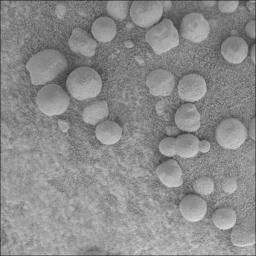
|
Finding the ‘Blueberry’ Muffin Recipe
- Click the image above for a larger view
- Full-Res JPEG (2048 x 2048) (484.1 kB)
- Full-Res TIFF (2048 x 2048) (3.8 MB)
Caption:
Scientists are hunting down the recipe for the "blueberries" they've discovered on Mars with the Mars Exploration Rover Opportunity. For location of the area dubbed "Berry Bowl" see PIA05563 .
To figure out the chemical composition of the blueberries, scientists are currently analyzing the area shown in the microscopic image with the rover's alpha particle X-ray spectrometer and Moessbauer spectrometer. The field of view for the alpha particle X-ray spectrometer is about equal to the field of view of the microscopic image and the field of view for the Moessbauer spectrometer is about half the size of the microscopic image, so the spectrometers will observe a mix of sand, rock, and blueberries. The blueberries are too small to analyze alone. Scientists will discern the blueberry spectra from the observed blend of spectra by subtracting out the known sand and rock spectra. Basically, finding the blueberry recipe is like making a recipe in reverse. Chemical measurements of the sand were taken earlier, and a measurement of the same rock in an area clear of the blueberries will be taken with the spectrometers on sol 48.
The "triple berry" seen in the center of the microscopic image is intriguing to scientists because it reveals a clue about how the blueberries formed. Spheres formed from impacts or volcanoes do not tend to mold together like the spheres seen in the microscopic image. Spheres from impacts or craters are usually round or teardrop-shaped from flying in the air and freezing before hitting the ground. Any droplets of magma that combine with other droplets usually grow into a single mass in a spherical, dumbbell, or teardrop shape. In contrast, concretions could form this triple berry shape. Concretions are spherical mineral structures formed by groundwater percolating through porous rocks. On Earth, as concretions grow in close proximity to each other, their outer edges often intersect each other, giving an appearance like a triple soap bubble.
Cataloging Keywords:
| Name | Value | Additional Values |
|---|---|---|
| Target | Mars | |
| System | ||
| Target Type | Planet | |
| Mission | Mars Exploration Rover (MER) | Mars Science Laboratory (MSL) |
| Instrument Host | Opportunity (MER-B) | Curiosity Rover |
| Host Type | Rover | |
| Instrument | Alpha Particle X-Ray Spectrometer (APXS) | Microscopic Imager (MI), Moessbauer Spectrometer (MB) |
| Detector | ||
| Extra Keywords | Crater, Grayscale, Impact, Volcano, Water | |
| Acquisition Date | ||
| Release Date | 2004-03-13 | |
| Date in Caption | ||
| Image Credit | NASA/JPL | |
| Source | photojournal.jpl.nasa.gov/catalog/PIA05564 | |
| Identifier | PIA05564 | |
